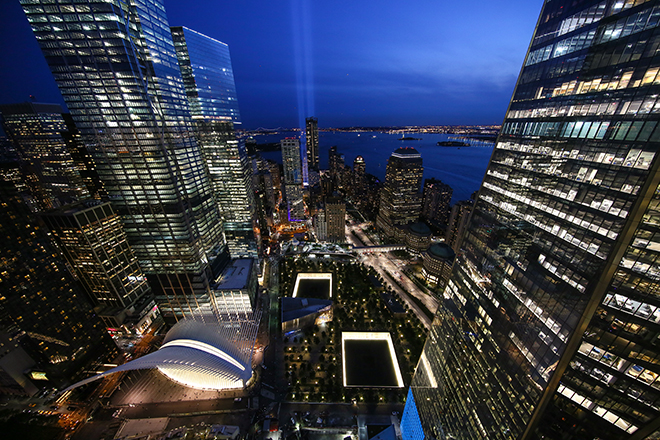S&P Global Offerings
Featured Topics
Featured Products
Events
S&P Global Offerings
Featured Topics
Featured Products
Events
S&P Global Offerings
Featured Topics
Featured Products
Events
Financial Institutions
Banking & Capital Markets
Economy & Finance
Energy Transition & Sustainability
Technology & Innovation
Podcasts & Newsletters
Financial Institutions
Banking & Capital Markets
Economy & Finance
Energy Transition & Sustainability
Technology & Innovation
Podcasts & Newsletters
S&P Global Offerings
Featured Topics
Featured Products
Events
13 Sep, 2021

By Ben Dyson
 A Tribute in Light shines near the site of the National September 11 Memorial & Museum, where the original World Trade Center once stood, in New York City.
A Tribute in Light shines near the site of the National September 11 Memorial & Museum, where the original World Trade Center once stood, in New York City.
Source: Silverstein Properties
Insurers, reinsurers and brokers are still grappling with how to best address terrorism risk and absorbing the lessons of the tragic events of Sept. 11, 2001, two decades after they shook the world.
Almost immediately after the attacks, the parts of the insurance and reinsurance industry that still covered terrorism risk excluded it, leading to the creation of several government-backed terrorism insurance schemes across the globe.
If nothing else, the attacks on the World Trade Center and Pentagon were a reminder to the insurance industry that it can be surprised. The events of that day underscored the importance of managing companies conservatively to ensure there are contingencies for large, unexpected claims, said Robert Hartwig, who at the time was chief economist of the Insurance Information Institute. He is now director of the University of South Carolina's Risk and Uncertainty Management Center.
"It is a good moment to reflect on those risks which are underwritten, but are not actually modeled," said Gordon Woo, a catastrophist at risk modeling firm RMS who created the company's terrorism risk model in the wake of the attacks. "That is a key takeaway on this 20th anniversary."
Market-changing event
Hundreds of insurance executives were among the 2,750 killed in New York City when hijackers flew two passenger jets into the World Trade Center's twin towers. Marsh McLennan lost 295 employees and 63 consultants, while Aon lost 176 employees. The attacks also generated the insurance industry's biggest-ever man-made loss — $47 billion in 2019 dollars, according to the Insurance Information Institute — and triggered changes that are still visible in the industry.
The attack affected multiple lines of business at once, creating "a shock to the system," according to David Priebe, chairman of Marsh & McLennan Cos. Inc.-owned reinsurance broker Guy Carpenter. Before the attacks, business line exposures were managed separately, Priebe said. The lessons that Sept. 11, 2001, taught the industry about risk correlation and aggregation across lines has made the industry "a far more disciplined and resilient business," he said in an interview.
The attacks prompted the U.S. Congress to write the Terrorism Risk Insurance Act, which was signed into law in November 2002. Similar pools were formed in Australia, France, Germany and the Netherlands. Work on these schemes "built a stronger public-private partnership between the industry and governments," Priebe said, which he expects to come into play more to tackle emerging systemic risks. The industry and government efforts ensured the continued availability of terrorism cover, Priebe said, and "hopefully we will do the same this time around with pandemics."
Hartwig said that if there was a "black eye" for the industry following the attacks, it was the long-running dispute between the World Trade Center complex's then-new owner, Silverstein Properties, and the complex's insurers, over whether the destruction of the twin towers constituted one event or two. The issue was exacerbated by the fact that the policy wording was not finalized when the attack hit.
"There was certainly an effort after that point to make sure that deals were tied up much more quickly after the lessons learned from this event," Hartwig said.
Test of strength
While exposing weaknesses, the events also reminded the industry of its strengths. Even though the industry had not "collected a penny of premium" for risks related to the surprise attacks, insurers were able to get through the disaster, Hartwig said.
Gregory Serio, then New York's insurance superintendent and now a managing director at lobbying firm Park Strategies, said the insurance industry deserves a "huge amount of credit" for providing economic stability immediately following the attacks.
"The government didn't send the first money to New York, the insurance companies did," he said.
Priebe said the reinsurance industry "did not shy away" from continuing to provide coverage, recalling work done to provide backup reinsurance for the remainder of the hurricane season that year. He also noted that a new class of insurers and reinsurers was formed rapidly to help replenish the $35 billion to $40 billion of capital he estimates the events removed from the market. Some of these companies, such as Arch Capital Group Ltd. and AXIS Capital Holdings Ltd., remain active.
Despite all the post-9/11 changes, Julian Enoizi, CEO of U.K. terrorism reinsurer Pool Re, does think the industry could address terrorism risk better. He noted that the market does not differentiate between large, spectacular attacks, which are "rightly left to the government," and more "eminently insurable" conventional attacks.
"There is a whole range of terrorist-type activity that could be insured by the private market and ... the private market hasn't really stepped up to it," Enoizi said.
Enoizi noted that Pool Re now reinsures £2.3 billion of its risk in the private market, including a £75 million terrorism catastrophe bond, which he said is the largest program in the world, but quite small compared to many natural catastrophe reinsurance programs.
"It just shows you how far away we are from a normalized market in terrorism insurance," Enoizi said.
